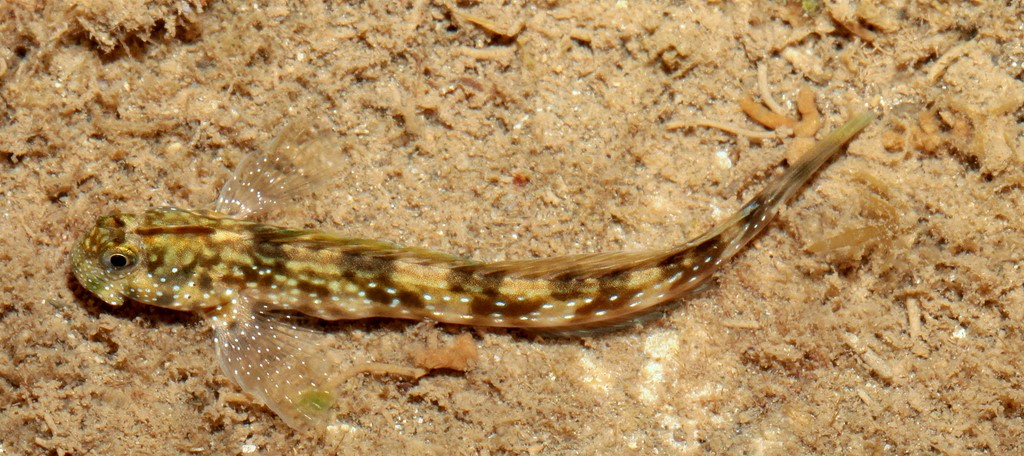PRAEALTICUS BILINEATUS - (PETERS, 1868)
Actinopterygii (Gigaclass) > Actinopteri (Class) > Teleostei (Subclass) > Blenniiformes (Order) > Blennioidei (Suborder) > Blenniidae (Family) > Salariinae (Subfamily) > Praealticus (Genus)
Blennie sauteur à points blancs, White-dotted rockskipper, Tamaginpo, タマギンポ , 双线冠鳚, 雙線冠鳚,
Synonymes
Istiblennius rennellensis (Rofen, 1958)
Salarias bilineatus (Peters, 1868)
Salarias biorni (Fowler, 1946)
Salarias macneilli (Whitley, 1928)
Salarias macneilli coloratus (Whitley, 1928)
Salarias sanna (Whitley, 1929)
Salarias schmidti (Fowler, 1946)
-----------------------------
Description
Dorsal spines (total): 13; Dorsal soft rays (total): 18-20; Anal spines: 2; Anal soft rays: 18-21; Dorsal fin deeply notched; Segmented caudal fin rays: usually 13-14, branched middle: 6-9; Pinnately branched supraorbital tentacle; Lacking nape cirri; Posterior rim of anterior nostril with small cirrus, typically unbranched; Upper and lower lip margins smooth; With occipital crest (higher in males); Last dorsal ray and caudal peduncle connected by membrane; Elongate body, depth at anal-fin origin ca. 7.7-7.9 in SL. Max. length: 9.0 cm TL. Depth range: 0 - 6 m.
Color
Head and body greyish brown with small white spots; Median fin with white dots.
Etymology
Praealticus: from Latin, prae = before, in front + from French, alticus= l’altique sauteur = “high jumper”. Referring to how, when grazing on algae outside the water on exposed rocks of the tidal zone, they skip and jump like wet lizards, especially when approached. Here the name refer in some way to its close superficial similarity to and/or close relationship with Alticus genus.
bilineatus: from Latin, bi = two + from Latin, lineatus, a, um = lined. Referring to two rows of small white dots.
Original description: Salarias bilineatus Peters, 1868 - Type locality: Coral reef east of Lauang, Samar Island, Philippines.
Distribution
Western Pacific: Indonesia to Solomon Islands and Vanuatu, New Caledonia to Japan.
Biology
Facultative air-breathing; Adults inhabit exposed rocky shores. Oviparous. Eggs are demersal and adhesive, and are attached to the substrate via a filamentous, adhesive pad or pedestal. Larvae are planktonic, often found in shallow, coastal waters.
Similar species
Last update: 10, September 2022
Blennie sauteur à points blancs, White-dotted rockskipper, Tamaginpo, タマギンポ , 双线冠鳚, 雙線冠鳚,
Synonymes
Istiblennius rennellensis (Rofen, 1958)
Salarias bilineatus (Peters, 1868)
Salarias biorni (Fowler, 1946)
Salarias macneilli (Whitley, 1928)
Salarias macneilli coloratus (Whitley, 1928)
Salarias sanna (Whitley, 1929)
Salarias schmidti (Fowler, 1946)
-----------------------------
Description
Dorsal spines (total): 13; Dorsal soft rays (total): 18-20; Anal spines: 2; Anal soft rays: 18-21; Dorsal fin deeply notched; Segmented caudal fin rays: usually 13-14, branched middle: 6-9; Pinnately branched supraorbital tentacle; Lacking nape cirri; Posterior rim of anterior nostril with small cirrus, typically unbranched; Upper and lower lip margins smooth; With occipital crest (higher in males); Last dorsal ray and caudal peduncle connected by membrane; Elongate body, depth at anal-fin origin ca. 7.7-7.9 in SL. Max. length: 9.0 cm TL. Depth range: 0 - 6 m.
Color
Head and body greyish brown with small white spots; Median fin with white dots.
Etymology
Praealticus: from Latin, prae = before, in front + from French, alticus= l’altique sauteur = “high jumper”. Referring to how, when grazing on algae outside the water on exposed rocks of the tidal zone, they skip and jump like wet lizards, especially when approached. Here the name refer in some way to its close superficial similarity to and/or close relationship with Alticus genus.
bilineatus: from Latin, bi = two + from Latin, lineatus, a, um = lined. Referring to two rows of small white dots.
Original description: Salarias bilineatus Peters, 1868 - Type locality: Coral reef east of Lauang, Samar Island, Philippines.
Distribution
Western Pacific: Indonesia to Solomon Islands and Vanuatu, New Caledonia to Japan.
Biology
Facultative air-breathing; Adults inhabit exposed rocky shores. Oviparous. Eggs are demersal and adhesive, and are attached to the substrate via a filamentous, adhesive pad or pedestal. Larvae are planktonic, often found in shallow, coastal waters.
Similar species
- Entomacrodus nigricans (Gill, 1859) - Reported from Western Atlantic. Olivaceous with seven short dark brown double bars on side of body and rows of small pale blue spots.
- Istiblennius meleagris (Valenciennes, 1836) - Reported from Southeastern Indian Ocean, southwestern Pacific: Australia. A pale brown to dark dusky-brown blenny with numerous small pales spots on the head and body, a series of irregular, more or less paired, broken bands (more obvious in females) along the sides and extending onto the dorsal-fin bases, oblique stripes on the dorsal fin in males, and dark spots in females.
- Praealticus margaritarius (Snyder, 1908) - Reported from Western Pacific: Japan.
Last update: 10, September 2022
